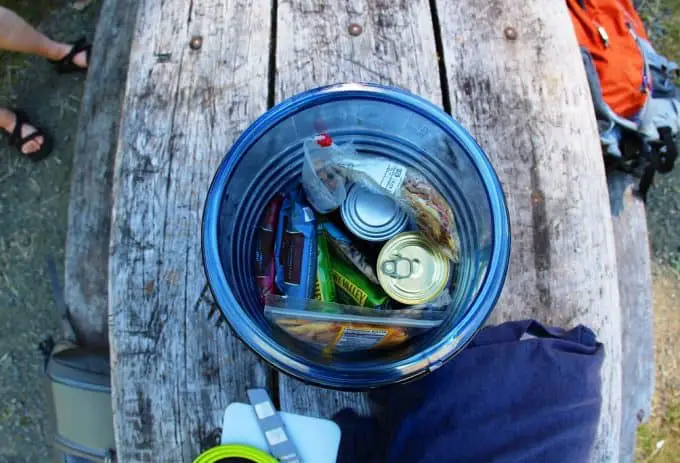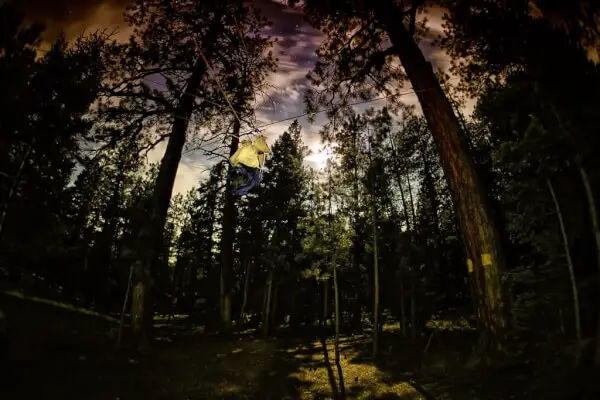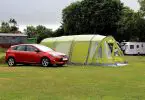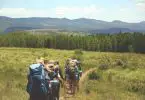Protecting your food supply while in the outdoors can be as simple as properly hanging a bear bag. When we are safe at home, we often take the availability of food for granted. Restocking an empty pantry can be achieved in mere minutes and in some places you do not even to leave the house. The story is much different when you are in the great outdoors.
If you are an expert at finding edible plants and are in an area where such food is readily abundant then there is not much to worry about. Most of us do not recognize such a beneficial skill and far fewer have received adequate training. Instead, the majority of outdoor enthusiasts must rely only upon the food we carry with us.
The smart adventurer will invest a considerable amount of time in planning the meals we will carry, but many unfortunate campers forget a crucial step, securing their food supply. Once you hit the trail it may be too late to prepare for the possibility of animals getting into your sustenance. It is potentially quite dangerous to underestimate the hunger and curiosity of wild animals in their environment.
Too many hikers and backpackers have gone to sleep with their stockpile of food tucked neatly away in a pack only to wake up and find their pack destroyed and their ruined food stores strewn across the ground. Animals, especially bears, are always on the move using their strong sense of smell to locate their next meal. When you bring your food into their domain, they can typically smell it long before you know they are even around.
In some cases they might just leave you alone, but their natural curiosity will typically draw them to your camp if for no other reason to investigate the interesting new smell you have introduced into their environment. The smart, experienced hikers will store their food in a safe manner and one of the most popular ways to accomplish this is the hanging of a bear bag.
This method puts your precious food supply out of reach from the ravenous appetite of bears and other wild animals.
Essential considerations
Materials
Just about any rope will do, provided it has a weight capacity sufficient to suspend your bag. It is good practice however, to carry a rope constructed from material that is both light and smooth. Thicker, heavier rope can cause damage to the bark and wood of trees, which of course is not very good stewardship.
If a heavier rope is all you have, then use it to secure your food supply, but try to prepare in advance if possible. The storage bag should be durable enough to withstand not only the weight of your storage, but should also be strong enough to withstand some measure of abuse should a bear be tall enough to swipe at it. A hanging bag that can tear too easily is likely to cause ultimate frustration.
Packing the Bag
Those inexperienced with the outdoors are often surprised to discover that even the smallest, almost insignificant item can attract a bear’s attention. Tiny tubes of toothpaste or even just a recently used toothbrush can emit enough of a scent as to attract unwanted attention. These kinds of items need to be stored securely and packed away from camp in a bear bag. They should never be left in your pack overnight and they most certainly should not be kept in your tent or hammock. Such items include:
- Food (including drink mixes)
- Toiletries such as toothpaste, toothbrush, soap, toilet paper
- Garbage (stored as safely as possible so as not to be exposed to food items)
- Clothing that has had food spilled on it
- Anything and everything you believe can emit some sort of attractive odor
Provided you adequately clean your cooking and eating utensils, these items can be stored in the cooking area, but away from your sleeping area.
Bag Location
Even a properly packed and hung bag is likely to attract attention so the safest practice is to locate an area for your food storage that is well away from your sleeping area. The bag should be hung at least 200 feet (300 feet preferably if possible) away from where you plan to spend the night. This location should also be downwind from you.
Additionally, the cooking area should be kept at a similar distance. Understanding this can be very helpful in identifying a suitable camping spot. If there isn’t a good place to hang a bear bag it is a good idea to keep moving until such a place can be found.
Methods
Those who have spent a considerable amount of time in the outdoors have developed their favorite methods of hanging a bear bag, but these personal styles are typically derived from two distinct methods, the single and double tree.
The Pacific Coast Trail (PCT) Method
A major advantage of the single tree, PCT method includes the use of less rope or cordage and one small carabiner. The reduction means less weight and room consumed in the pack compared to other hanging styles. It is also important to note that this type of bear bag can be hung using only a single tree compared to other methods that require two trees.
When executed properly, the PCT method can typically be much more difficult for a bear or other animal to thwart. Some methods require securing one or more ropes to a tree and bears are often clever enough to slash at these ropes until they split and spill the contents on the ground. The versatility of the PCT includes the ability to attach another small rope through the carabiner so that items such as toilet paper or soap can be accessed without bringing the larger bag down to the ground.
There is a disadvantage to this method when hanging large, heavy bags, it can become difficult to secure the rope with the required clove hitch. This is also affected by numerous bags being hung on one rope, which is often necessary with groups of hikers. Naturally, because this method was developed in the Pacific Northwest, there is a need for tall trees with long, strong and bare branches for this type of hanging to work properly.
Check out: Paracord Uses: The Only Limit is Your Imagination
To hang the bag, attach a small, but heavy item to the end of your rope. Rocks work best, but sometimes it can be difficult to find such a stone of sufficient size and weight. In such a case it can be useful to stuff a small ditty bag with smaller rocks or soil to provide the throwing weight. Filling the small bag with essential camping items is NOT recommended as there is the possibility that the bag could become stuck in a high, inaccessible branch.
In addition, some instructions for the PCT include attaching a carabiner to the throwing end and then attaching the weight to this clip. The danger is that if your rope gets caught you are out one carabiner. Instead, wait until the rope is safely tossed before attaching additional equipment.
Throw the weighted end over a thick, sturdy branch at a distance of at least six feet from the trunk and a height of at least twelve feet. Once the rope clears the branch and falls back to the ground, remove the weight and secure a carabiner to one end of your rope. Attach your bear bag to the carabiner and then feed the other end of the rope through the carabiner loop.
To raise the bear bag simply pull the loose end of the rope until the bag is suspended at least twelve feet above the ground. To secure the bag, take a small stick in one hand then reach up as high as you can and secure a clove hitch around it with the pulling rope. Slowly let the weight of the bag bring it back down until the twig engages the carabiner. Some people skip this step and instead tie the end of the rope around the trunk of the tree.
Two-Tree Method
Because sometimes you will be venturing through areas hit hard by wildfires or younger forests there may not be a single tree with branches high enough or strong enough to support your bag. In this case you may be forced into having to hang your bag between two separate trees. The challenge can be finding two suitable trees that are growing close enough together, but are also far enough away from your camp and in the right direction.
This method also requires considerably more length of rope than the single tree method. This point alone makes it very important that you do a little research about the area you will be travelling through long before you hit the trail. Without enough rope to span two trees, you may find yourself in a dangerous situation. To begin this method you will need to throw one end of your rope over the branch of a tree and secure it to its trunk.
The remaining loose end then needs to be thrown over the branch of a second tree with enough slack so that the middle of the rope hangs close to the ground. Attach your bear bag to the this center of the rope. Take the loose end and pull it tight so that it raises the bag to a sufficient height. Secure the loose end to the tree trunk.
This process can pose some measure of difficulty, but with practice can be done with confidence. Of course the obvious weakness of this system is that now you have two ropes that are typically fastened to the trees low enough for a curious bear to get their sharp claws on them. Instead of the potential of a single possible point of failure, this method has two.
When to Hang the Bag
Regardless of which method you choose, the best time to hang your bear bag is as soon as you decide to make camp. Such decisions are often made towards the later part of the day. Trying to identify adequate and separate sleeping, cooking and sleeping areas can prove difficult as the light of day gives way to night.
Camp activities also create a distraction that might keep you from noticing the approach of a wild animal. Separating your attractive storage before engaging in other activities creates a safer environment for you and for wildlife as well.
A Third Alternative
Some wilderness campsites are distinctly marked and park staff will have already identified a proper place to hang bear bags. Some of these locations will even have already strung strong wires between predetermined trees for your use. Don’t neglect these thoughtful benefits as they are often provided by people who know their business far better than most hikers. Forest stewardship is everyone’s responsibility. For the types of ropes you can use, check out our article on this topic.
Alternative Storage
There are areas where hanging a bear bag is not possible. Local laws or regulations may prohibit such activities and of course, there are areas where there are no trees at all, or the trees are not suitable for bag hanging. Some of these more traveled areas may have campsites equipped with bear-resistant canisters or other storage solutions.

It is very important to do your research before traveling to such a remote location because if they do not have such facilities you will need to bring a bear-resistant canister. These specially designed containers can withstand the abuse bears can inflict and are impossible for them to open. See our review of the best bear canisters to help you choose the right one for your needs.
Some people actually prefer this method over hanging bear bags since it saves time and room for extra gear. The canisters can be somewhat expensive though so those planning a single trip may be able to rent them from local sporting supply stores.
Conclusion
Don’t fall into the false notion that keeping your stores safely away from bears is for your protection alone. While it is true that bears, especially hungry bears, have been known to attack humans on occasion, they typically shy away from people. Sometimes though, the promise of an easy meal can bring even shy bears in close quarters with people in the backcountry.
When they achieve success in thwarting camper’s attempts to secure their food, they eventually begin to associate humans with easy access to food. Such animals become a danger to themselves as forest agents may find it necessary to eliminate animals that prove to be a routine threat. As with most outdoor activities, hanging bear bags can take a little getting used to, but with enough practice, they can be thrown up in very little time. For more important tips on how to ward off bears from campsite, check out out our must-read article.
You would be wise to develop these skills should long before necessity demands them. Try out these methods near the safety of home until you have confidence you can do it when there is no help available.
Featured Image Source: “Bear Bag” by /\ltus is licensed under CC BY-NC-SA 2.0







